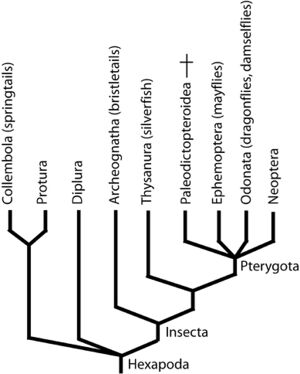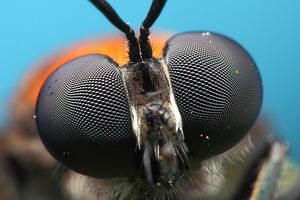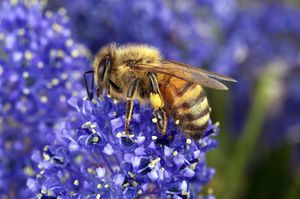Hexapod
File:Hexapoda.jpeg
Classification
Kingdom: Animalia
Phylum: Arthropoda
Subphylum: Hexapod
Hexapods are a subphylum of arthropoda phylum. Hexapods can be broken down into two groups: insecta and entognatha. Those in the insect group have 3 pairs of legs, a set of wings, and compound eyes. There are more than 1 million species of insects. Those in the entognatha group do not have wings but posess the other features of the insecta group. The entognatha group has mouthparts that can be retracted into their head.
Features of Hexapods
Hexapods are composed of three sections: the head, the thorax, and the abdomen. Along with this, hexapods are invertebrates, meaning that they lack a spine.
On a hexapods head, they have a pair of antennae and compound eyes [1][2]. Compound eyes allow hexapods to use their peripheral vision without having to move their head or body. This helps them escape predators and seek out prey.
On each segment of a hexapod, they have one pair of legs. Some hexapods, such as the dragonfly and the fly, have wings. However, many do not and instead travel using different methods. For example, the collembola doesn't have wings and travels by its furcula which allows it to jump far distances.
Hexapods, like all insects, have a hard exoskeleton that protects the insect's internal organs.
Habitat
Hexapods are mostly terrestrial species, but a small portion of the species can live in lakes, wetlands, rivers, and marine waters. Hexapods do avoid sub-tidal marine environments because they are unable to survive in shallow seas and the ocean.
Environmental Effects
Hexapods do both positive and negative things for the environment. Hexapods are vital for the pollination of flowering plants. Some hexapods, like bees, carry pollen to neighboring flowers. Without them, flowering plants would not be able to germinate. However, Hexapods can also do vast damage to crops as well as spread diseases to other animals and humans.
References
[1] “Hexapoda - the Insects: Wildlife Journal Junior - Wildlife Journal Junior.” New Hampshire PBS, https://nhpbs.org/wild/Hexapoda.asp.
[2] “Discover How Scientists Have Recreated the Benefits of Insects' Compound Eyes as Compound Lenses.” Encyclopædia Britannica, Encyclopædia Britannica, Inc., https://www.britannica.com/video/216533/Artificial-bug-eyes-could-lead-to-new-vision-systems.
[3] Strauss, Bob. “Hexapods Are a Diverse Group of Six-Legged Arthropods.” ThoughtCo, ThoughtCo, 10 Jan. 2020, https://www.thoughtco.com/hexapods-myriapods-129501.
- ↑ “Discover How Scientists Have Recreated the Benefits of Insects' Compound Eyes as Compound Lenses.” Encyclopædia Britannica, Encyclopædia Britannica, Inc., https://www.britannica.com/video/216533/Artificial-bug-eyes-could-lead-to-new-vision-systems.
- ↑ “Discover How Scientists Have Recreated the Benefits of Insects' Compound Eyes as Compound Lenses.” Encyclopædia Britannica, Encyclopædia Britannica, Inc., https://www.britannica.com/video/216533/Artificial-bug-eyes-could-lead-to-new-vision-systems.


